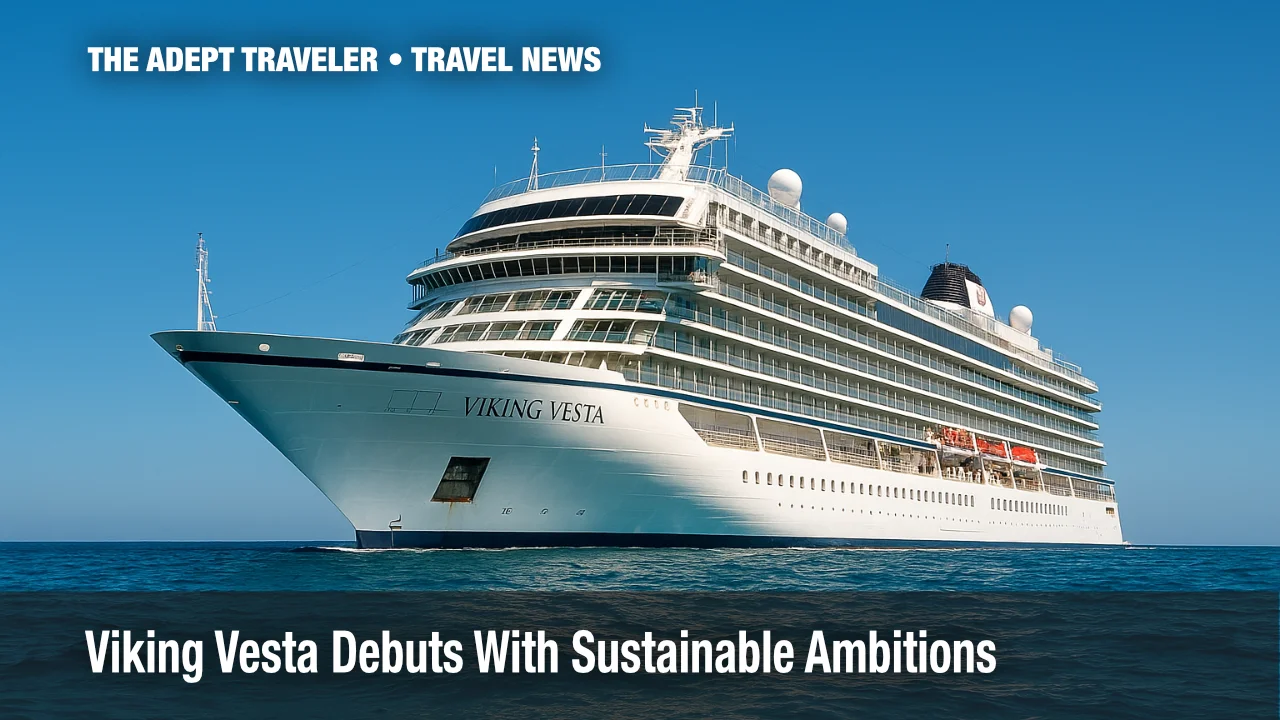Viking Vesta Debuts With Sustainable Ambitions

Viking Vesta, the newest 998-guest ocean vessel from Viking, has officially joined the line's 100-plus-ship pipeline. Fresh off the Fincantieri slipway in Ancona, the 499-stateroom ship will spend her maiden summer tracing sun-soaked Mediterranean coasts before heading north for cool-weather itineraries in Scandinavia and the British Isles. The debut not only enlarges Viking's ocean roster but also signals the brand's steady march toward cleaner propulsion and an ambitious goal of 23 ocean and expedition ships by 2031.
Key Points
- 998-guest Viking Vesta delivered in Italy this week
- Inaugural routes cover the Mediterranean and Northern Europe
- Fleet plan adds 27 new river ships by 2028 and 10 ocean ships by 2031
- Hydrogen-powered Viking Libra launches in 2026, Viking Astrea in 2027
- Why it matters: Travelers gain more low-emission cruise options
Viking Vesta Snapshot - How It Works
Viking Vesta follows the line's familiar small-ship blueprint: a capacity under 1 000 guests, all verandah staterooms, and a no-casinos policy that prioritizes destination immersion over onboard spectacle. Public areas mirror sister ships, with Nordic-inspired lounges, expansive alfresco dining, and a glass-backed infinity pool cantilevered over the stern. The vessel's size allows access to midsize ports that mega-liners often skip, trimming tender time and keeping excursions intimate. Stateroom technology remains energy-efficient, and shore-power connectivity lets the ship cut engines in select ports, reducing local emissions.
Viking Vesta Background Brief - Why Add It
Viking's ocean division began only in 2015, yet demand for the line's understated, lecture-rich product quickly outpaced capacity. Mediterranean summers habitually sell out a year in advance, and Northern European sailings see similar traction when paired with cultural deep dives such as exclusive museum after-hours tours. Expanding the ocean fleet allows Viking to protect its river-cruise base while absorbing luxury-migration trends from legacy brands. Fincantieri's modular construction shortcuts the learning curve: each new hull retains the proven layout, streamlining training and maintenance while introducing incremental efficiency gains. By 2031, the company envisions a balanced portfolio of classic ocean, expedition, and river hardware that shares crew pipelines and purchasing power.
Viking Vesta Latest Developments
The handover ceremony in Ancona marks the first of three pivotal milestones Viking will hit before the decade closes.
Fleet Expansion Timeline
Viking projects 111 river vessels by 2028 and 23 ocean and expedition ships by 2031, effectively doubling total berth capacity within six years. The construction cadence averages four river longships and one ocean ship per year, backed by multi-yard contracts across Europe. Early steel cutting for Viking Polaris II, an expedition sister, is already underway at VARD, illustrating how parallel yard work keeps schedules tight.
Hydrogen-Powered Ships on the Horizon
The forthcoming Viking Libra, due in late 2026, is the company's first vessel designed for zero-emission operation in select modes thanks to liquid-hydrogen fuel cells that supplement traditional dual-fuel engines. According to Fincantieri engineers, the hybrid system can eliminate hotel-load emissions during port stays and reduce underway carbon output by up to 40 percent compared with conventional marine gas oil. A second hydrogen-ready hull, Viking Astrea, enters the build queue next year for a 2027 delivery, underscoring the line's intent to scale the technology quickly.
Delivery Schedule Through 2028
Beyond hydrogen prototypes, Viking's orderbook includes seven additional ocean ships of the current Vesta class and 27 river longships configured for the Rhine, Danube, Seine, and Nile. Hull slotting is sequenced to keep at least one vessel debuting each quarter, preserving market buzz and allowing itinerary designers to thread new ports into existing calendars. Travelers can already pre-register interest for 2027 voyages via the line's online booking portal, while travel advisors gain early commission windows through the company's preferred-partner program.
Analysis
For cruisers, more Viking tonnage means greater date flexibility and a wider spread of shoulder-season departures that often carry lower fares. The modest size of Viking Vesta counters the current megaship arms race, appealing to guests who value space but dislike crowds. Port variety should improve as well: coastal gems such as Porto, Cádiz, and Bergen can accommodate a sub-1 000-guest ship without tender congestion, translating to longer in-port hours and smoother shore-excursion logistics. From a sustainability angle, incremental gains aboard Vesta foreshadow bigger leaps on Viking Libra and Astrea. Travelers keen on greener cruising will soon have mainstream options that rival expedition hybrids. Meanwhile, veteran river guests eyeing their first ocean voyage can look forward to familiar Scandinavian design cues and enrichment-first programming. Advisors should monitor bedding variations and cabin-class tweaks across newbuilds, as subtle differences affect inventory mapping in GDS systems. For detailed destination insights, see our Mediterranean cruise guide and Northern Europe port primer.
Final Thoughts
Viking Vesta's arrival signals more than another hull in the harbor. It illustrates the line's dual commitment to capacity growth and cleaner propulsion, with hydrogen-ready sisters waiting in the wings. Travelers who crave port-intensive itineraries without resort-at-sea distractions will find the ship a comfortable fit, while sustainability-minded guests can book knowing future voyages aim for lower footprints. Keep an eye on Viking Vesta's late-season Northern Europe slots, which often combine mild weather with thinner crowds and sharper pricing. Booking early secures the widest cabin choice, yet wait-listing shoulder-season departures can yield upgrade surprises. Either way, Viking Vesta promises to deliver the line's signature quiet luxury - and, soon, a pathway to cleaner cruising.
